During the week of activities, several key themes came to the fore that contributed to our discussions and thinking about inclusive education, including: attitude to risk; roles, relationships and power dynamics; languages and identity; indigenous pedagogies and decolonisation. These themes will be elaborated on throughout this blog in relation to the activities that inspired them.
Liz Curtis and Kirsten Darling-Mcquistan flew in from Aberdeen on Monday April 17 and after meeting up with Anne-Mette Bjøru at the UiT-campus the next morning, they presented a guest lecture to Bachelor students studying Special Education.
The lecture showed similarities and differences between the two countries regarding inclusive education, and some of the students had questions and comments that ignited further discussion about the topic. The principle of inclusive education has gained foothold in both countries’ framework for education, and knowing about how and why the principle has become central is important – but so is also learning how to implement the principle into practice. Liz and Kirsten presented exactly that, via examples from a small school in rural Scotland and its 6-week archaeology project. It was an interdisciplinary project where archaeologists, teachers and learners planned and executed the project together. Thus, roles, relationships and power dynamics created a learning environment were everyone was learning form each other. The end product was an exhibit, and the pupils were allowed to choose activities and take the lead themselves in how they wanted to develop the pieces they wanted to display. Framing the project as co-creation of knowledge, secured the learners’ participation and enhanced an inclusive practice.
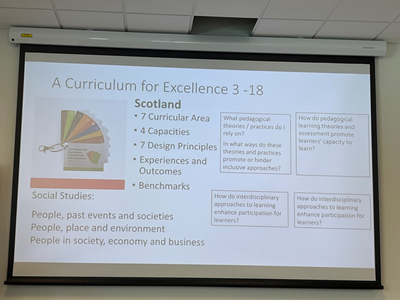
Recordings of the lectures: https://youtu.be/ozNRC8s3Yik & https://youtu.be/c8PKED7yqwU
In the afternoon we visited The Arctic University Museum, where we saw exhibits about WWII and Sámi history and culture. This was a very impactful visit that framed much of our understanding of Sámi culture and language. This was an important visit where Kirsten and Liz gained further insights into the oppression and marginalisation experienced by the Sámi communities. Displays in the museums picturing Sámi children being ‘westernised’ through education/schooling were stark. We gained a sense of the ways in which Sámi ways of being, knowing and doing were silenced and even erased in very familiar classroom settings. These images stayed with us and encouraged us to further question what can be lost when dominant understandings of knowledge erase the rich histories, traditions, and ways of being of marginalised communities. Does inclusive education go far enough in its attempts to create school experiences that value a multiplicity of perspectives and ways of being? Or are we still just working at the edges?
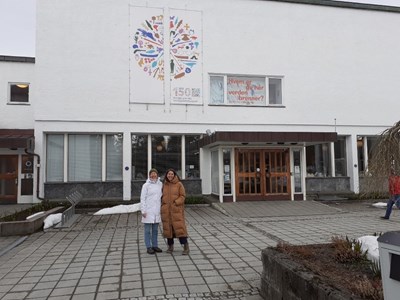
The next morning, we ventured across the bridge to Kvaløya - an island north of Tromsø - where we visited Ersfjordbotn school (information in Norwegian only). It is a 1st through 7th grade multi-stage/multi-grade/few divisions school.
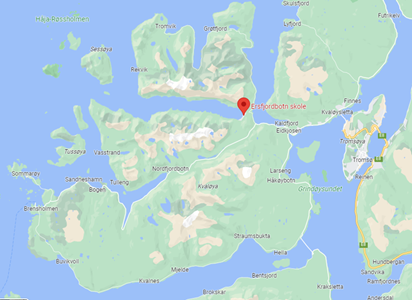
Photo: google maps
We were welcomed warmly to the school and instantly felt the relaxed, calm ethos of the teaching team as the children began to arrive on their skis or bikes and in full winter weather gear. We were kindly invited to join two classes. The teachers, who had plans for the morning, set their plans aside, valuing the opportunity for the children to talk with English-speaking visitors. We enjoyed talking with the children and attempting to answer their questions about Nessie and what school is like for children in Scotland. Through our interactions it became clear that the children, who were not wearing uniform, were interacting with their class teacher on first name terms. We commented on this and told the children that in Scotland calling a teacher by the first name would be considered disrespectful. We also learnt about the ways the children and teachers harness the local environment, especially when the weather is conducive, to explore and learn in the outdoors. The children told us about their annual school race up a mountain, swimming in the Fjords, camping and cooking on fires. Taken together, these interactions told of very different teacher-student relationships and attitudes towards risk: the children were respectful, the teacher was respectful. These respectful relationships were not because of rituals of schooling, e.g. wearing uniform, using teachers’ surnames, that characterize schooling in Scotland. Here in this school in Norway, there was a genuine sense of dialogue, collaboration, trust and above all learning: responsive learning that capitalised on opportunities, whether that be a fleeting beak in the harsh winter weather, or the arrival of visitors.
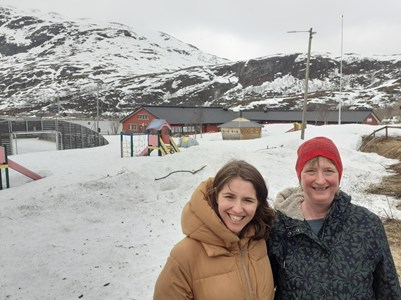
We went back to the university in the afternoon where Liz gave a talk to one of the research groups at the Department of Education, ICred – Intercultural relations in education (information in Norwegian only). It was a very interesting talk, followed by a good discussion where also new contacts were made and new opportunities for collaboration on certain common topics. Here the conversation turned once more to colonizing forces of education and the importance of recognizing the diversity and the plurality of- and within the educational field.
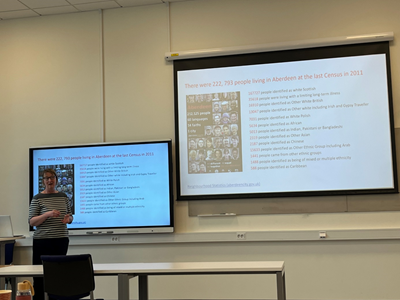
On Thursday we visited the Sámi class at Prestvannet school/Báhpajávrri skuvla (information in Norwegian only), close to Tromsø city center. Prestvannet is a regular 1-7 grade school, which includes a Sámi line of study where all subjects are taught in Sámi language. This is also organized in a multi-grade way, and grades 1-2, 3-4 and 5-7 are taught together. We visited the 5-7 graders and were welcomed by curious pupils who asked the guests from Scotland a lot of questions. Many of the pupils spoke excellent English, and easily shifted between English, Norwegian and Sámi language during our conversation at the beginning of the visit. Once the subject teaching began Sámi language was used, and after an introduction to the topic given to the whole group pf pupils together, the pupils worked in pairs or individually with given tasks. While working with the tasks, we could not hear that the pupils shifted to Norwegian at any time, even though the city of Tromsø and the school are predominantly Norwegian speaking communities. This might imply the importance of an all Sámi language line of study at schools where the pupils’ may speak and develop their 1st language through all aspects of a school day, both when learning subject matter and socially.
In the evening we were invited to a guided tour at the NNKM – Nordnorsk kunstmuseum, Northern Norway Art Museum where the curator showed us the exhibition Gába – female resistance. Gába means ‘skilled woman’ in North Sámi language and the exhibition showed works by twelve living women artists who identify as Sámi or northerners. Materials used was local materials such as fish skin, yarn, and sand. You may read more about the exhibition here.
Friday morning it was time to say goodbye. We returned back to Aberdeen and Alta bringing with us new knowledge about each other's practices. The value of collaborative projects such as ConnectED is not easily explained – learning from and with each other not only teaches us about education systems and practices abroad, but also reminds us about our own systems and practices which are important to be aware of and reflect about.
About the project
The ConnectED project aims to create connections between early career scholars and researchers across the Arctic by organising a series of researcher visits. The project is funded by UArctic project funding for Network Activities on Arctic Research and Education, allocated by Danish Agency for Science and Higher Education (DAFSHE) and administrated by UArctic International Secretariat.
The project is part of the activities of the UArctic Thematic Network on Teacher Education for Social Justice and Diversity in Education
Project Manager:
Kalpana Vijayavarathan,
Associate Professor
The University of the Faroe Islands
KalpanaV(at)setur.fo
Read the original blog post on the Teacher Education for Social Justice and Diversity website.
